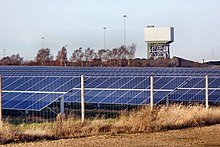Solar power in the United Kingdom
There were few installations until 2010, when the UK government mandated subsidies in the form of a feed-in tariff (FIT), paid for by all electricity consumers.
In the following years the cost of photovoltaic (PV) panels fell,[1] and the FIT rates for new installations were reduced in stages until the scheme closed to new applications in 2019.
Home rooftop solar panels installed in 2022 were estimated to pay back their cost in ten to twenty years.
Solar power installations increased rapidly in subsequent years, as a result of reductions in the cost of PV panels, and the introduction of a feed-in-tariff (FiT) subsidy in April 2010.
[1] At the end of September 2013, retailer IKEA announced that solar panel packages for houses would be sold at 17 UK stores by July 2014.
[25] UK solar PV installed capacity at the end of 2017 was 12.8 GW, representing a 3.4% share of total electricity generation.
[30] MCS (Microgeneration Certification Scheme) claim 61,320 UK properties had solar panels installed in 2021, an increase of 71% on the previous year.
[31] The average payback time for residential solar PV in the UK was 11.4 years as of 2015,[30] but subsequent increases in the price of domestic energy have significantly decreased this.
It will take anything from 4 to 20 years to recoup the money spent on solar panels, this depends on a number of factors for example how many modules you have, how big they are, if they are south facing and where you live.
In his Spring Statement of March 2022, Chancellor Rishi Sunak announced a reduction of VAT on the installation of energy-saving materials (including solar PV systems) to 0% (previously 5%) for a period of five years from 1 April 2022, stating "the measure is intended to incentivise the take-up of ESMs in line with the government's net zero objectives".
[51] Adding solar panels to the external elevations and roofs of a dwelling will change the appearance of both the property and the local street view.
Otherwise, the owner of a domestic dwelling where solar panels are being installed can in most cases proceed under their Permitted Development rights, as long as certain height limitations are adhered to.
[54] The UK government agreed in April 2010 to pay for all grid-connected generated electricity at an initial rate of up to 41.3 pence (US$0.67) per kWh, whether used locally or exported.
[55] The rates proved more attractive than necessary, and in August 2011, were drastically reduced for installations over 50 kW,[56] a policy change criticised as marking "the end of the UK's solar industry as we know it".
The Department for Business, Energy and Industrial Strategy published a consultation on 19 July 2018, stating their intention to close the FIT scheme to new applicants from 1 April 2019[60] and not replace it with a new subsidy.
This is not a direct replacement of the feed-in tariff scheme, but rather an initiative that rewards solar generators for electricity exported to the grid.
The SEG is available to households that generate up to 5 MW from solar PV, wind, micro-combined heat and power, hydro or anaerobic digestion.

